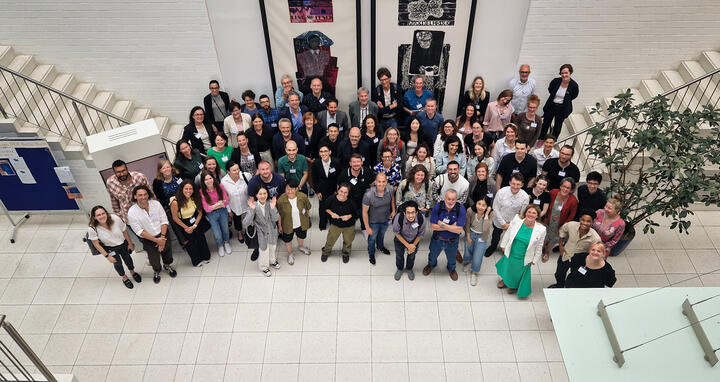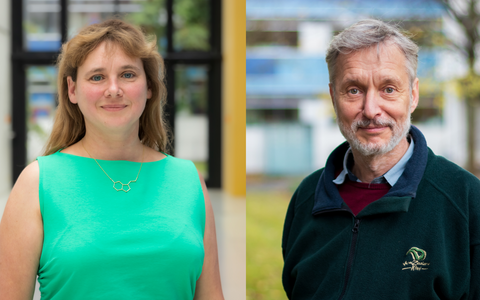So much more than a feel-good hormone
Dr. Natalia Alenina and Professor Michael Bader
Dr. Alenina, Prof. Bader, a single molecule – the neurotransmitter serotonin – held the attention of more than 130 researchers for two days at the Max Delbrück Center. What role does it play in our body?
Bader: Serotonin is more than just a neurotransmitter. It is also a signaling molecule that is mainly produced in the gut, from where it is distributed throughout the entire body by blood platelets. There it acts as a hormone and is involved in such things as blood clotting, wound healing, and inflammation. Serotonin also modulates many functions in the brain, including sleep, appetite, and mood.
Is the molecule rightly considered a happiness hormone?
Alenina: Serotonin and also dopamine most definitely play a role in feeling happy. Almost all the drugs we know increase the effect of these two neurotransmitters. It is also known that reduced serotonin levels lead to depression. So the treatments we use are geared toward increasing the availability of the neurotransmitter in the brain. In addition, it has been seen that animals that do not produce serotonin in the brain become very aggressive. The molecule therefore seems to be involved in a wide range of emotions.
Influencing gene activity
Why were the discoveries made in 2003 so important, so much so that you dedicated the conference to them?
Bader: Back then, we had discovered that serotonin is produced not by one, but by two enzymes in the body. The enzyme TPH2, which was unknown until then, is active primarily in the brain. We had also found out that serotonin not only attaches itself to the receptors on cells’ surfaces, but also penetrates the cells. There it can bind to proteins and influence their functions. Both of these were completely new findings.
What important discoveries have been made about serotonin since then?
Bader: Using the knockout mice we generated, which can only produce serotonin in the brain but not in the periphery, we have shown that the signaling molecule also plays a major role in the development of pulmonary hypertension – a severe condition with a poor prognosis. Our mice were protected from this disease. In addition, researchers in the US have discovered that serotonin even binds to histones, the packaging material of DNA. This means it is also involved in regulating gene activities.
Therapeutic agents against pulmonary hypertension
To what extent can such observations be put to medical use?
Bader: We have developed substances that inhibit the enzyme TPH1 so that only small amounts of the neurotransmitter are produced outside the brain. In animal models we were able to show that they can be used to cure pulmonary hypertension. And now, just a few days ago, we founded the company Trypto Therapeutics to translate the therapeutic agents into clinical practice. We are also looking to advance therapies for other diseases associated with serotonin, such as skin and lung fibrosis.
What new technologies have recently accelerated serotonin research?
Alenina: What is very important for us is optogenetics, which enables us to study how serotonin affects the activity of different neurons in the brain. Single-cell sequencing and calcium imaging in the brain are also very helpful in serotonin research.
What was the highlight of the conference for you?
Bader: I was especially pleased that we were able to engage our Swedish colleague Kjell Fuxe from Karolinska Institutet as keynote speaker. Fuxe, who is now 85 years old, discovered way back in the early sixties where in the brain the serotonin-producing cells are located. It’s a foundational paper that all of us cite over and over again. There were also very interesting lectures, in particular Ian Maze’s talk on histone serotonylation and the one by Daniel Hoyer on the use of psilocybin mushrooms and MDMA (a.k.a. Ecstasy) in the treatment of depression.
Important for early growth
What unanswered questions about serotonin are you and your colleagues particularly interested in at the moment?
Alenina: We have seen that mammals lacking serotonin in their brains grow much more slowly in the first weeks of their lives than do other mammals. However, when weaned from their mothers and given food other than milk, they quickly and fully catch up. This phenomenon has yet to be explained. As part of the EU-funded research network “Serotonin and Beyond,” two PhD students from our team are currently investigating the still unknown role of serotonin in early development.
Is there another meeting already planned on the topic of serotonin?
Bader: Yes, most of us will certainly see each other again at the next meeting of the International Society for Serotonin Research, which will be held in Vienna in 2025. I’m excited about what we will find out by then.
Anke Brodmerkel conducted the interview.







